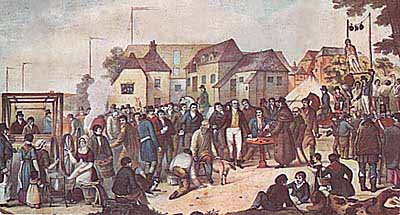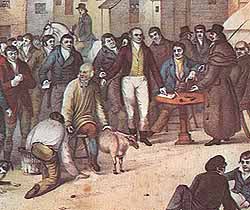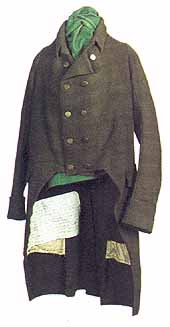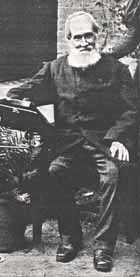
RBH Home
Maps & Travels
Articles
Legends
Towns & Villages
Castles & Houses
Churches
Biographies
Gentry
Family History
Odds & Ends
Mail David
The Newbury Coat
A Sheep's Coat at Sunrise, A Man's Coat at Sunset
 It is no new
thing for us to see records established one day and beaten the next, the
top place nowadays being no sooner reached by one individual than
challenged by, another. The record in the manufacture of cloth, however,
with which this article deals, though of eighty-eight years' standing, has
never yet been eclipsed.
It is no new
thing for us to see records established one day and beaten the next, the
top place nowadays being no sooner reached by one individual than
challenged by, another. The record in the manufacture of cloth, however,
with which this article deals, though of eighty-eight years' standing, has
never yet been eclipsed.
The scene of this remarkable achievement in the sartorial art is the village of Newbury, Berkshire, and it came about in this way. Mr. John Coxeter, a then well-known cloth manufacturer, the owner of Greenham Mills, at the above-named village, remarked in the course of conversation one day in the year 1811 to Sir John Throckmorton, Bart., of Newbury, "So great are the improvements in machinery I have lately introduced into my mill, that I believe that in twenty- four hours I could take the coat off your back, reduce it to wool, and turn it back into a coat again."
The proverb says, "There's many a true word spoken in jest. "So great an impression did Mr. Coxeter's boast make upon the Baronet, that afterwards he enquired of Mr. Coxeter if it would really be possible to make a coat from sheeps' wool between the sunrise and sunset of a summer's day. That gentleman, after carefully calculating the time required for the various processes, replied that in his opinion it could be done.
Not long after the above conversation, which took at a dinner party, Sir John Throckmorton laid a of a thousand guineas that at eight o'clock in the evening of June the 25th, 1811, he would sit down to dinner in a well-woven, properly-made coat, the wool of which formed the fleeces of sheeps' backs at five o'clock that same morning. Such an achievement appearing practically impossible to his listeners, his bet was eagerly accepted.
 Sir John
entrusted the accomplishment of the feat to Mr. Coxeter and shortly before
five o'clock on the morning stated, the early-rising villagers of Newbury
were astonished to see their worthy squire, accompanied by his shepherd
and two sheep, journeying towards Greenham Mills. Promptly at five o'clock
operations commenced, and no time was lost in getting the sheep shorn.
Our first illustration, which is from an old print executed at the time,
shows the sheep being shorn by the shepherd, and is worthy of a little
attention. Sir John stands in the middle of the picture, having his
measurements taken by the tailor, and it is an interesting fact that,
except that all implements to be used were placed in readiness on the
field of action, the smallest actual operations in the making of the coat
were performed between the hours mentioned.
Sir John
entrusted the accomplishment of the feat to Mr. Coxeter and shortly before
five o'clock on the morning stated, the early-rising villagers of Newbury
were astonished to see their worthy squire, accompanied by his shepherd
and two sheep, journeying towards Greenham Mills. Promptly at five o'clock
operations commenced, and no time was lost in getting the sheep shorn.
Our first illustration, which is from an old print executed at the time,
shows the sheep being shorn by the shepherd, and is worthy of a little
attention. Sir John stands in the middle of the picture, having his
measurements taken by the tailor, and it is an interesting fact that,
except that all implements to be used were placed in readiness on the
field of action, the smallest actual operations in the making of the coat
were performed between the hours mentioned.
Mr. Coxeter stands just behind the sheepshearer, watching with an anxious eye, whilst to the right (see full picture top) may be seen a tent, which was erected presumably for refreshments, and schoolboys climbing a greasy-pole and generally making the best of the holiday which had been accorded them in order that they might witness this singular spectacle.
 The sheep being
shorn, the wool was washed, stubbed, roved, spun, and woven, and our next
illustration, also from an old print, shows the weaving, which was
performed by Mr. Coxeter Junior, who had been found by previous
competition to be themost expert workman. In the background of this
picture may be
seen the carcass of one of the sheep; of which more later. The
curious-looking objects in the basket, held, by the way, by another of Mr.
Coxeter's sons, are wool spools, while in the extreme background, looking
out of the window of a quaint old cottage, may be seen "the gods in
the gallery."
The sheep being
shorn, the wool was washed, stubbed, roved, spun, and woven, and our next
illustration, also from an old print, shows the weaving, which was
performed by Mr. Coxeter Junior, who had been found by previous
competition to be themost expert workman. In the background of this
picture may be
seen the carcass of one of the sheep; of which more later. The
curious-looking objects in the basket, held, by the way, by another of Mr.
Coxeter's sons, are wool spools, while in the extreme background, looking
out of the window of a quaint old cottage, may be seen "the gods in
the gallery."
When we compare the primitive-looking loom seen in this picture with the powerful machinery of today, the record then established certainly becomes all the more wonderful.
The cloth thus
manufactured was next scoured, fulled, tented, raised, sheared, dyed, and
dressed, being completed by four o'clock in the afternoon. Just eleven
hours after the arrival of the two sheep in the mill-yard. In the
meantime, the news of the wager had spread abroad among the neighbouring
villages, bringing crowds of people eager to witness the conclusion of
this extraordinary undertaking. The cloth was now put into the hands of
the tailor, Mr. James White, who had already got all measurements ready
during the operations, so that not a moment  should
be lost: and he, together with nine of his men, with needles all threaded,
at once started on it. For the next two hours and a quarter the tailors
were busy cutting out, stitching, pressing, and sewing on buttons, in
fact, generally converting the cloth into a "well woven, properly
made coat," and at twenty minutes past six Mr. Coxeter presented the
coat to Sir John Throckmorton, who put the garment on before an assemblage
of over five thousand people, and sat down to dinner with it on, together
with forty gentlemen, at eight o'clock in the evening
should
be lost: and he, together with nine of his men, with needles all threaded,
at once started on it. For the next two hours and a quarter the tailors
were busy cutting out, stitching, pressing, and sewing on buttons, in
fact, generally converting the cloth into a "well woven, properly
made coat," and at twenty minutes past six Mr. Coxeter presented the
coat to Sir John Throckmorton, who put the garment on before an assemblage
of over five thousand people, and sat down to dinner with it on, together
with forty gentlemen, at eight o'clock in the evening
The next illustration shown is a photograph of this wonderful coat. The garment was a large hunting-coat of the then admired dark Wellington colour, a sort of a damson tint. It had been completed in the space of thirteen hours and ten minutes, the wager thus being won with an hour and three quarters to spare.
To commemorate the event, the two sheep who were the victim of Mr. Coxeter's energy were killed and roasted whole in a meadow nearby, and distributed to the public, together with 120 gallons of strong beer, this latter being the gift of Mr. Coxeter.
 Our
next illustration is an 1899 photograph of Mr. Charles Coxeter,
of Abingdon, Berks, the last living eye-witness to this feat. He was the
younger brother to the weaver of the cloth, long since dead, who is shown
in our second illustration. His age at the time was ninety-three. When
approached on the subject he said he well remembered the event, and
recalls with pleasure seeing the workmen dine off portions of the sheep,
in a barge on the river near the mill. The original mill unfortunately no
longer stands, having long since been destroyed.
Our
next illustration is an 1899 photograph of Mr. Charles Coxeter,
of Abingdon, Berks, the last living eye-witness to this feat. He was the
younger brother to the weaver of the cloth, long since dead, who is shown
in our second illustration. His age at the time was ninety-three. When
approached on the subject he said he well remembered the event, and
recalls with pleasure seeing the workmen dine off portions of the sheep,
in a barge on the river near the mill. The original mill unfortunately no
longer stands, having long since been destroyed.
We now give an illustration of the silver medal which was struck in honour of the occasion. It is worded as follows:
 "Presented
to Mr. John Coxeter, of Greenham Mills, by the Agricultural Society, for
manufacturing wool into cloth and into a coat in thirteen hours and ten
minutes."
"Presented
to Mr. John Coxeter, of Greenham Mills, by the Agricultural Society, for
manufacturing wool into cloth and into a coat in thirteen hours and ten
minutes."
Mr. Coxeter was a very enterprising individual, for seemingly not content with this wonderful achievement, not many years after, in connection with the public rejoicings for peace after the Battle of Waterloo, he had a gigantic plum-pudding made, which was cooked under the supervision of twelve ladies. This monster pudding measured over 20ft in length, and was conveyed to his house on a large timber waggon, drawn by two oxen, which were highly decorated with blue ribbons. The driver was similarly ornamented, and bore aloft an old family sword of state, presumably to give éclat to the occasion. Arrived at its destination, the pudding was cut up in the celebrated old mill-yard at Greenham, and distributed to all and sundry, those who had the good fortune partake of it pronouncing the pudding to be "as nice as mother makes 'em."
 The
famous coat which found a resting-place in a glass case in Sir John
Throckmorton's hall at Buckland House, was exhibited at the great
International Exhibition of 1851, where it attracted a great deal of
attention. A few copies of the old engravings from which our first two
illustrations are reproduced being eagerly bought up. Our last picture
shows the bill which was printed for that exhibition.
The
famous coat which found a resting-place in a glass case in Sir John
Throckmorton's hall at Buckland House, was exhibited at the great
International Exhibition of 1851, where it attracted a great deal of
attention. A few copies of the old engravings from which our first two
illustrations are reproduced being eagerly bought up. Our last picture
shows the bill which was printed for that exhibition.
Over thirty years afterwards the coat was again brought before public notice, this time at the Newbury Art and Industrial Exhibition of 1884. Though to us it may seem rather a curious cut for a hunting-coat, it was the approved style for those times, the long coat-tails flying to the wind during a chase. Needless to say, however, this coat has never been used for that purpose.
These are certainly days of speed, and though probably with the vastly superior machinery of today (1899) this wonderful performance could be eclipsed, it is interesting to notice that up to the present it has never been equalled.
Since the above article was originally published in 1899, the making of the famous 'Newbury Coat,' as the garment has become known, has been re-enacted only once. On September 21st, 1991, a second identical Newbury Coat was produced in exactly the same manner, but beating the previously set record by a whole hour. The second Newbury Coat can now be seen in the West Berkshire Museum in Newbury. The original left Buckland with the Throckmortons and is now on display at their Warwickshire home of Coughton Court.
